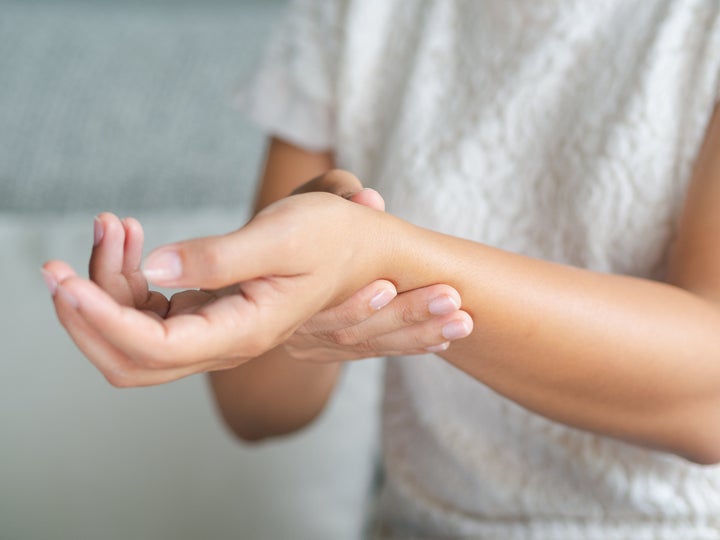
The evening before my 4-year-old daughter, Hannah, and I went to Philadelphia, she carefully chose her favorite stuffed animal, coloring books and bathing suit. I carefully chose the right mixture of medications to ensure I’d get enough pain relief to sleep, but not so much that I’d keep sleeping if she needed me in the middle of the night.
I’d wanted to travel with Hannah before. “Y’all should come visit!” one of my aunts had urged me just a few months earlier.
I wanted so badly to say yes, but we lived in Washington, D.C., and she was in rural Florida. Decades of chronic pain in my right wrist, shoulders and neck had damaged my muscles and joints to the point where I couldn’t handle the physical strain of carrying our bags, hurrying Hannah through the Atlanta airport and helping her into her seat.
Chronic pain was the reason our trip to Philadelphia would only be one night. It was my trial balloon, a low-stakes way to find out what kind of trip I could take with her. Two hours of driving, a hotel within walking distance of several museums, dinner with friends who understood my limitations, and a willingness to splurge on room service and valet parking: These were the bulwarks I could erect against the relentless muscle spasms and unceasing joint pain.
Hannah is 8 years old now. She nods solemnly when I say that I need to take a pain pill and I won’t be able to eat dinner with her and her father that night. She knows which of the many ice packs is my favorite, and brings it to me when I ask. On days when my wrist hurts so much that I need to wear my largest brace, I hear Hannah casually tell her friends, “Sarah broke her arm a long time ago and now she puts that on sometimes.”
It’s not the most accurate story ― I’ve never broken my arm; the pain began spontaneously ― but it’s the way she makes sense of my pain. It’s Hannah’s story.
My family’s story, like so many others, changed this year. Hannah hasn’t been inside her elementary school since March 12. That same day, my office and my husband’s closed down, and our physical life became circumscribed to the tight confines of our house and immediate neighborhood.
I am accustomed to living a circumscribed life. As the pain has worsened throughout my adult life, hobbies and passions have fallen by the wayside: playing an instrument, going to the gym, photography, baking. A good day is when I can work, be present for my family and, if I’m lucky, have a conversation with a friend.
And yet as the pandemic hit D.C., my life as a mother, paradoxically, opened up. Abruptly deprived of her friends, my only child turned to the next best thing ― her parents. More specifically, she turned to me, since my work schedule was more flexible than my husband’s.
Out came colored pencils, markers and paints; we passed the long hours after her truncated virtual school day by drawing pictures, building forts and turning our basement into an imaginary kingdom for our dogs and cat, complete with cardboard shields and coats of arms.
Hannah joined me in the kitchen as I baked bread and muffins, first for our family and then to donate to a food pantry. We listened to music ― she always chose Taylor Swift, I always chose R.E.M. ― as I taught her to knead bread and fill muffin tins.
At the end of each day, my wrist ached and my shoulder muscles were hard as concrete, but I didn’t want to stop. Our drawings and bread were tangible proof that in the midst of our sadness and disorientation, we could still create something lovely.
Even more than that, spending that time with Hannah was good for my mental health. I was rediscovering activities that I’d given up years ago, enjoying the soothing calm and relating to my daughter in a new way. As long as I could take pain medications when needed and ice my joints at night, I thought, the benefits outweighed the drawbacks.
But the physical toll was undeniable, and my treatment options were curtailed. With doctors’ offices closed, the procedures I relied on to help control my pain were suspended indefinitely.
As a result, I had flare-ups so severe that I landed in the emergency room twice, sobbing until my mask was soaked through, shaking with pain and feeling like a failure: I had pushed myself past the edge of endurance and crashed spectacularly. My pain eventually settled back to a manageable level, but Hannah lost her partner in art and baking.
Pandemic parenting has made me think about the Philadelphia trip a lot. I was so nervous in the days leading up to our departure; I tightly controlled what I could and overprepared for every possible setback. Compared to the devastation of this year, those concerns seem so insubstantial, relics of a long-ago time. Yet I still draw strength from those memories of Philadelphia, because I know that, even when the limitations of my body overshadow me and Hannah, we can still find moments of grace.
There was a pool at the hotel, a placid, subterranean circle of blue tiles and still water. We slid into the water, skin winter-pale. It was Hannah’s first time swimming with me. She clutched the edge of the pool as I paddled away and back, shaking her head even as I encouraged her.
Treading water, I took her small hands in mine and pulled her gently toward me. Her expression shifted from hesitant to joyful by the time I clutched her against my body, the first time I’d been able to carry my daughter since she was 5 months old. I was dizzy with the shock of Hannah in my arms, a feeling that I’d long accepted I’d never experience again.
Hannah locked her legs around my waist as I twirled us through the water, spinning us in ever-widening circles, our giggles starting soft and growing wilder. Drops of water balanced at the ends of her dark eyelashes and dampened her nose as we moved from one side of the pool to the other. We stayed in the pool even after my body started to shake with cold, because I didn’t know when I would be able to carry her again, because she was weightless and I was strong.
Sarah Erdreich lives in Washington, D.C., with her family, and can be found on Twitter @chronicpaindc. She is working on a memoir about living with chronic pain.
Do you have a compelling personal story you’d like to see published on HuffPost? Find out what we’re looking for here and send us a pitch!
